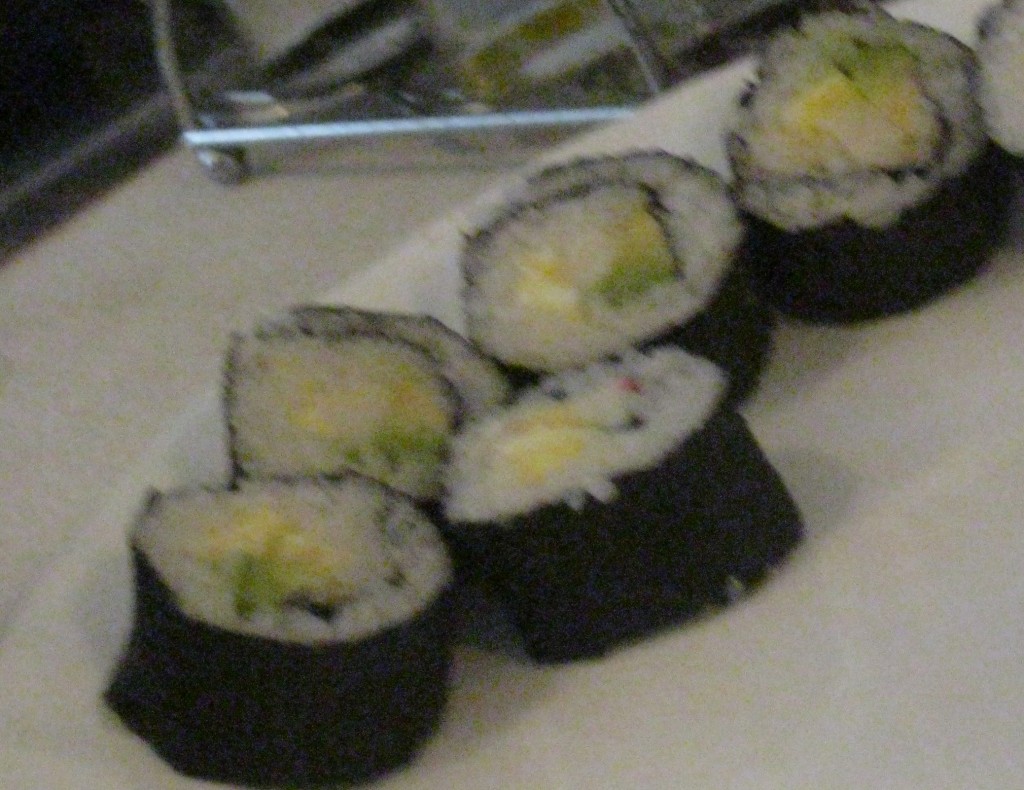This is not a food blog, but there are a few favorite foods that have become part of our lives since moving to Asia that we don’t know how we’d do without. Sushi is one of those foods, and one my kids beg me to make. Let me be clear, however. Although JavaMan and I like the raw fish variety, no one under 10 years of age in our house will sample that kind. This demonstration is for California roll-type sushi.
I was taught how to make it by a Korean-Chinese friend, but even after that, was fairly intimidated by the process. My first attempts weren’t stellar, but now I’m an old pro. I can even make it when pressured for time as was proven on Sunday when we were short of roasted seaweed and carrots and had to run out for more at the last minute before the Dream in High Park.
Not pictured here: raw carrots (JavaMan was out buying more)
Ingredients:
- 6 tbsp. raw vinegar
- 3 tbsp. honey (my recipe calls for 5 tbsp. sugar, but I use honey instead of sugar in most recipes, and cut the honey in about half, as it’s sweeter)
- 3 tsp. salt
- 2 cups Japanese or Thai rice
- roasted seaweed (sushi nori)
- imitation crab meat (or the real thing!)
- avocado (if you can’t find this, as we can’t in China, cucumber is a fair substitute)
- carrots
- soy sauce and wasabi for dipping–yum!
- a good, sharp knife
- a sushi mat (There is no substitute for this. You should be able to find one at an Asian grocery.)
Procedure:
- Cook the rice. We use a rice cooker, but stove top is fine too. When cooking Asian white rices, the proportion of rice to water is 1 cup rice, 1-1/4 cups water. You don’t want your rice overly wet. [Just a note here: when I first started making sushi after the initial demonstration, I brushed up by watching an online video. Both my teacher and the video used a truer technique–start out with fairly wet rice and stir until your arm falls off to achieve the desired dryness and stickiness. In this technique, the amount of rice vinegar, honey and salt is doubled for the same amount of rice. Do this if you want; it takes a lot longer, but your arms will develop good muscles. I fooled around with the recipe until I arrived at something that works every time, and involves far less muscle. I never told anyone in the family what I did to the recipe, but they all like it better now.]
- Combine the rice vinegar, salt and honey in a pot and cook until the salt dissolves.
- While things are cooking, cut up your vegetables into thin strips. I cut up my imitation crab, too–into quarters, lengthwise.
- Beat the eggs and cook them in a non-stick frying pan like an omelet, but as the eggs begin to hold together, use your spatula to shove them into a narrow strip. It doesn’t really matter how beautiful your egg looks when it’s all done. You’re going to cut it into thin strips, just like everything else. But it’s helpful to have it all in one roll. Like this:
![IMG_1691[1] cooked egg for sushi](https://careyjaneclark.com/wp-content/uploads/2011/08/IMG_16911-1024x768.jpg)
- Pour into the rice mixture while still hot [Again, original recipe says to cool it first. See how much time I’m saving you?]
![IMG_1689[1] add the rice vinegar mixture to the cooked rice](https://careyjaneclark.com/wp-content/uploads/2011/08/IMG_16891-1024x768.jpg) Stir until you achieve a sticky consistency and the liquid is completely absorbed into the rice. I tend to kind of mash the rice a little with the spoon as I stir. It should look a little like this:
Stir until you achieve a sticky consistency and the liquid is completely absorbed into the rice. I tend to kind of mash the rice a little with the spoon as I stir. It should look a little like this:![IMG_1690[1] sushi rice](https://careyjaneclark.com/wp-content/uploads/2011/08/IMG_16901-1024x768.jpg) Now comes the fun part. Lay out your sushi mat so the strings that bind it together are vertical in front of you on top of a clean surface, like a cutting board.
Now comes the fun part. Lay out your sushi mat so the strings that bind it together are vertical in front of you on top of a clean surface, like a cutting board.- Place the sushi nori (roasted seaweed) on top of the sushi mat, shiny side down, lines vertical, just like the sushi mat. These lines give the direction for the cuts, and it will be difficult to cut the sushi afterward if you get this wrong.
![IMG_1693[1] sushi nori (roasted seaweed)](https://careyjaneclark.com/wp-content/uploads/2011/08/IMG_16931-1024x768.jpg)
- With the nori lying down on the mat, hold the nori with one hand while you spread the rice out, starting at the left and working to the right (if you’re a righty). With a little experience, you’ll notice that the nori has a tendency to tear if you try to work away from you. Instead, work left to right and then away from you, spreading a layer to cover the nori. I like to make mine small, since they’re a little easier to work with. This means covering with a little less rice. Want a bigger roll? Use more rice. Don’t spread rice all the way to the edge. Leave a little nori at the end that doesn’t have rice on it. You can put a little water along the upper edge of the nori if you want it to seal better. I often don’t do that, and it seals just fine with the rice.
![IMG_1695[1] spreading rice on the sushi nori](https://careyjaneclark.com/wp-content/uploads/2011/08/IMG_16951-1024x768.jpg)
- Now, spread your vegetables, crab meat and egg slices horizontally along the lower edge (closest to you) in straight lines. Leave about half an inch to an inch of space at the bottom before you spread out the vegetables. This gives you some room to start the roll when it’s time to roll. We have a little video of this, during which no one in the family could be convinced to be quiet, so here you are with life at our house, unedited AND sushi rolling.
- Take your sharp knife in hand and cut the rolled sushi to the desired thickness, and arrange the finished pieces on a plate to serve. Again, we make ours on the small side, since it lasts longer with all the hungry little mouths. You may end up “discarding” the ends, as the vegetables, nori and rice don’t always come out evenly, but I usually have some helpers handy who will take care of the disposal. If they make it that far, I serve the end pieces on top, like little garnishes.
![IMG_1699[1] Cutting the sushi rolls](https://careyjaneclark.com/wp-content/uploads/2011/08/IMG_16991-1024x768.jpg)
(The hand waving wildly at the end there is me trying to tell my son to “cut” the video. He was my photographer throughout this little demo. This is his credit.)
Et Voila! Serve warm and eat it all or invite someone over to help eat it up, because sushi does NOT refrigerate well. Enjoy.
![IMG_1686[1] sushi ingredients](https://careyjaneclark.com/wp-content/uploads/2011/08/IMG_168611-1024x768.jpg)




